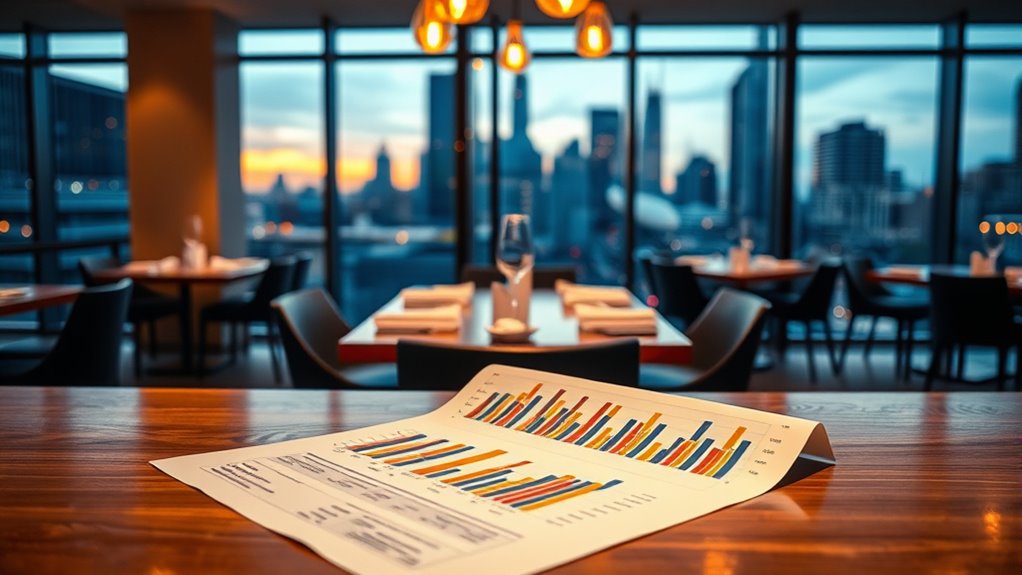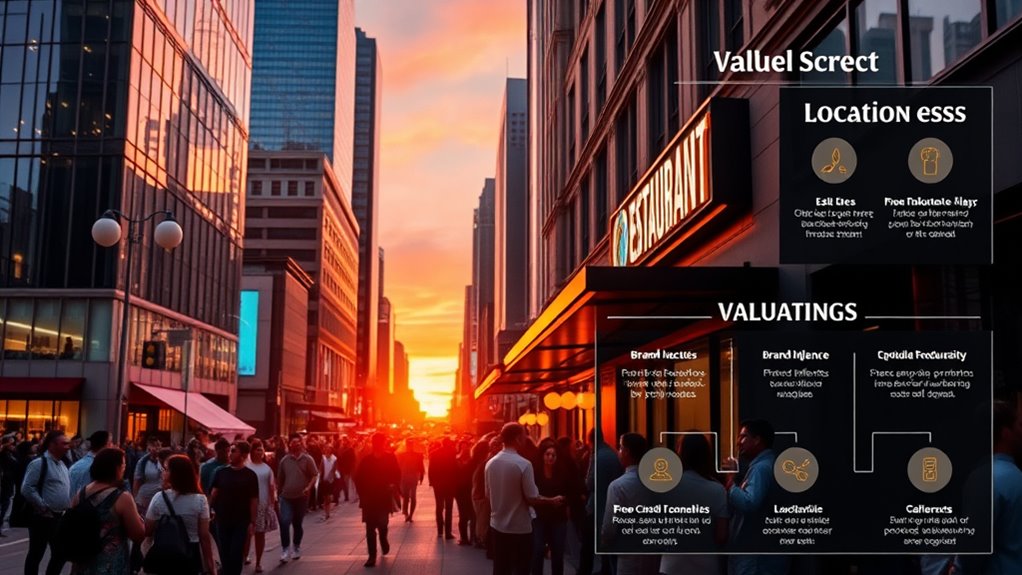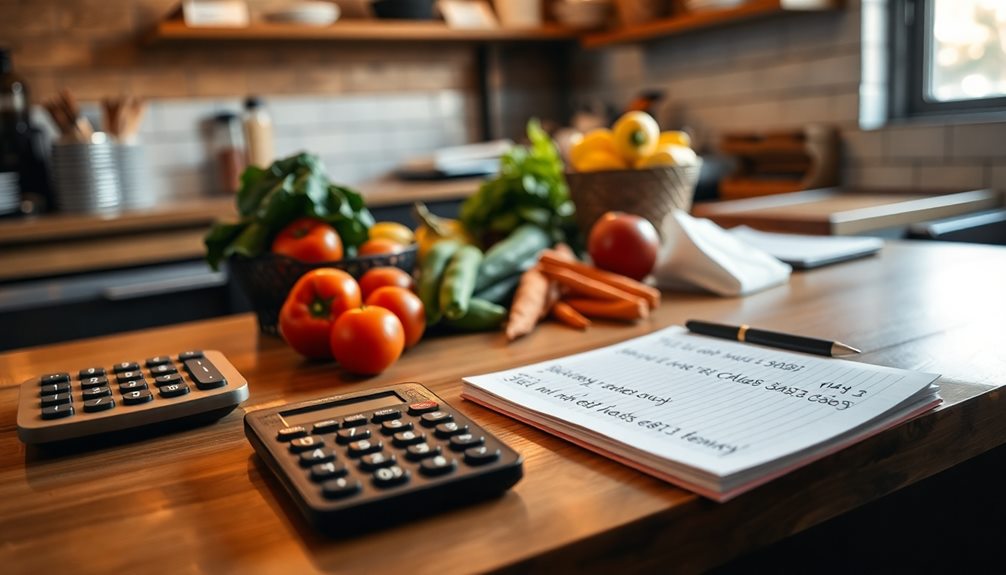To understand restaurant valuation methods, you should explore different approaches like the asset-based method, which values tangible and intangible assets; the income approach, focusing on revenue and profit potential; and the market comparison, which looks at recent sales of similar businesses. Additionally, discounted cash flow analysis estimates future earnings. Considering factors like brand strength, location, and market conditions can give you a more complete picture. Keep exploring to learn how these elements work together.
Key Takeaways
- Multiple valuation methods include asset-based, income approach, market comparison, and discounted cash flow analysis.
- Revenue, profit margins, and market conditions significantly influence restaurant valuation accuracy.
- Intangible factors like brand strength, location quality, and customer experience are crucial for comprehensive assessment.
- Combining different approaches ensures a balanced, reliable estimate of a restaurant’s value.
- Incorporating trends like AI-powered marketing and design enhances valuation by reflecting modern market dynamics.
The Asset-Based Approach

The asset-based approach focuses on evaluating a restaurant’s worth by calculating the total value of its tangible and intangible assets. You start by listing physical items like kitchen equipment, furniture, and real estate, then assign current market values to each. Next, you consider intangible assets such as brand reputation, customer lists, and proprietary recipes. These are added together to determine the restaurant’s total asset value. This method is especially useful if the restaurant is underperforming or has significant physical assets. It provides a clear snapshot of what the business owns outright, regardless of future earnings potential. Keep in mind, however, that this approach doesn’t account for future income streams or profitability, making it more suitable for liquidation or asset-heavy businesses. Contrast ratio can also influence perceptions of value when assessing image quality and overall presentation of the restaurant’s branding or interior design.
The Income Approach

When using the income approach, understanding the capitalization rate is essential because it determines how your restaurant’s income converts into its value. You’ll need to analyze revenue and profit metrics carefully, as they directly impact this rate. By focusing on these points, you can better assess the true worth of the restaurant based on its earning potential. Additionally, being aware of merchant services risks and costs can help you evaluate your financial stability and potential for growth.
Capitalization Rate Significance
Have you ever wondered how investors determine the value of a restaurant based on its income? The capitalization rate, or cap rate, plays a pivotal role in this process. It represents the expected return on investment and helps convert the restaurant’s income into an estimated value. A lower cap rate indicates less risk and usually results in a higher valuation, while a higher cap rate suggests more risk and a lower value. Factors influencing the cap rate include location, market conditions, and the restaurant’s financial stability. Understanding the cap rate allows you to compare properties effectively and assess investment potential. Fundamentally, it’s a key indicator that helps you determine whether a restaurant’s income justifies its asking price. Additionally, market conditions can fluctuate over time, impacting the appropriate cap rate for a given property.
Revenue and Profit Metrics
Ever wonder how investors gauge a restaurant’s worth based on its earnings? They focus on revenue and profit metrics to determine the business’s financial health. Key figures include gross revenue, which shows total sales, and net profit, indicating what remains after expenses. You’ll want to analyze trends over time to see if earnings are growing or declining. Profit margins reveal operational efficiency, helping you assess if the restaurant manages costs well. These metrics serve as the foundation for valuation models like the income approach. By understanding how much profit the restaurant generates relative to its sales, you can estimate its value more accurately. Ultimately, strong revenue and profit figures suggest a more valuable restaurant, making these metrics essential for investors and buyers alike. For a comprehensive evaluation, incorporating vacuum performance metrics can provide insights into operational efficiency and cleanliness standards within the restaurant.
The Market Comparison Method

How do investors determine a restaurant’s value quickly and accurately? They often use the Market Comparison Method, which involves looking at recent sales of similar restaurants in your area. You identify comparable businesses with similar size, cuisine, location, and age. Then, you analyze their sale prices relative to their revenues or earnings, establishing a price-to-earnings or price-to-revenue ratio. Using these ratios, you estimate your restaurant’s value by applying them to your own financial figures. This method is practical because it reflects current market conditions and investor sentiment. Keep in mind, though, that the accuracy depends on finding truly comparable sales. It’s a quick way to get a ballpark figure, especially when market data is readily available. Additionally, understanding restaurant valuation methods can help you make more informed decisions in the industry.
The Discounted Cash Flow Analysis

When using the Discounted Cash Flow (DCF) analysis, you start by estimating the restaurant’s future revenue streams to determine its potential value. The discount rate you choose is vital because it reflects the investment’s risk and affects the present value of cash flows. Accurate cash flow estimation is essential, as it directly influences the reliability of your valuation.
Future Revenue Projections
Future revenue projections play a crucial role in restaurant valuation, providing a foundation for estimating the business’s potential growth and profitability. By analyzing past sales trends, seasonality, and market conditions, you can develop realistic forecasts of future income. Accurate projections help you determine how much cash the restaurant might generate over time, which is essential for the discounted cash flow analysis. Consider factors like upcoming menu changes, renovations, or new locations that could impact revenue. Be cautious not to overestimate growth; conservative estimates lead to more reliable valuations. Regularly update your projections as market conditions evolve. Additionally, understanding market demand and consumer preferences can significantly influence revenue forecasts and the overall valuation accuracy. Ultimately, these forecasts serve as the backbone for calculating present value, guiding investors and owners in making informed decisions about the restaurant’s worth.
Discount Rate Significance
Why is the discount rate so vital in the discounted cash flow (DCF) analysis? It directly influences the present value of future cash flows, reflecting the investment’s risk and opportunity cost. A higher discount rate indicates greater risk, lowering the present value and signaling less attractive investments. Conversely, a lower rate suggests stability and increased value. Selecting the appropriate discount rate is essential because it balances risk and return expectations, affecting your overall valuation. If the rate is too high, you might undervalue the restaurant; if too low, you could overestimate its worth. Understanding how to determine and apply the correct discount rate ensures your analysis accurately reflects the investment’s true value, guiding smarter decision-making in restaurant acquisitions or sales. Incorporating organization-specific risk factors can further refine the valuation process.
Cash Flow Estimation
How do you accurately estimate a restaurant’s cash flows to determine its value? Start by projecting future earnings based on historical data, considering factors like sales trends, seasonality, and industry conditions. Adjust these projections for upcoming changes, such as renovations or marketing strategies. Focus on free cash flow, which is the cash available after operating expenses and capital expenditures. Discount these future cash flows to their present value using an appropriate rate, reflecting risk and time value of money. This process, known as discounted cash flow analysis, helps you estimate what the restaurant is truly worth today. Precise cash flow estimation is essential, as it directly influences the accuracy of your valuation and investment decisions.
Valuing Brand and Location Factors

Brand strength and location are critical factors that can profoundly influence a restaurant’s valuation. A well-established brand attracts loyal customers and can command higher prices, while a prime location boosts visibility and foot traffic. To assess these factors, consider their impact on revenue potential and market positioning. Use the following table to evaluate key aspects:
| Factor | Evaluation Criteria |
|---|---|
| Brand Equity | Recognition, reputation, customer loyalty |
| Location Quality | Accessibility, visibility, neighborhood appeal |
Strong branding and a strategic location can considerably increase value, sometimes more than tangible assets alone. These factors often serve as multipliers in valuation models, reflecting their importance in future earning potential. Additionally, integrating insights from AI Entertainment trends, such as AI-powered marketing and customer engagement tools, can further enhance a restaurant’s competitive edge and valuation.
Combining Methods for a Comprehensive Valuation

Combining different valuation methods provides a more complete picture of a restaurant’s worth, capturing both tangible assets and intangible factors like brand strength and location. By using multiple approaches—such as the asset-based, income, and market comparison methods—you can cross-verify estimates and identify discrepancies. This integrated approach helps you account for unique aspects of the restaurant, like loyal customer base or prime real estate, that might be overlooked with a single method. For example, while the income approach emphasizes profitability, the market comparison considers how similar establishments are valued. Additionally, understanding the design elements and layout of a restaurant can influence its overall value, especially in terms of customer experience and branding. By blending these methods, you develop a balanced view that reflects both the financial performance and market position of the restaurant, leading to a more accurate and reliable valuation.
Frequently Asked Questions
How Do Seasonal Fluctuations Affect Restaurant Valuation?
Seasonal fluctuations can substantially impact your restaurant’s valuation by causing revenue variability throughout the year. When sales dip during off-peak seasons, it might lower your business’s overall value, even if your annual profits are strong. Investors and buyers consider these patterns, so you should analyze and present consistent seasonal data. Managing and mitigating seasonal effects can help you maintain a stable valuation and attract better offers.
What Role Do Lease Agreements Play in Valuation?
Lease agreements substantially influence restaurant valuation because they impact operating costs and stability. When you assess a restaurant’s worth, you consider lease terms, rent costs, and renewal options. Favorable leases with low rent and long durations add value, while unfavorable ones can decrease it. A clear, manageable lease structure reassures investors and buyers, making the restaurant more attractive. Consequently, understanding lease agreements helps you accurately determine its overall market value.
How Is Employee Turnover Factored Into Valuation?
You might wonder how employee turnover impacts valuation. High turnover can signal management issues or poor working conditions, which could hurt profitability. When valuing a restaurant, you’re likely to consider turnover rates because they affect labor costs and customer experience. If turnover is high, it might reduce the restaurant’s value, as it indicates potential instability and increased hiring expenses. As a result, you factor employee retention into your overall assessment of the business’s worth.
Can a Restaurant’s Online Reputation Impact Its Valuation?
Your restaurant’s online reputation directly affects its valuation, impacting customer trust, brand strength, and revenue potential. Positive reviews and high ratings attract more diners, boost sales, and increase profitability. Conversely, negative feedback can deter customers, reduce sales, and lower valuation. In today’s digital age, reputation management is essential—your online presence influences investor confidence, future growth prospects, and ultimately, the worth of your restaurant.
How Do Future Industry Trends Influence Valuation Methods?
You should recognize that future industry trends markedly influence valuation methods. As consumer preferences shift toward healthier options, delivery services, or technology integration, you’ll see these changes reflected in a restaurant’s projected revenue and growth potential. Valuations adapt accordingly, emphasizing innovation and adaptability. By staying ahead of trends, you can better position your restaurant’s value, ensuring it aligns with evolving market demands and investor expectations.
Conclusion
By understanding these valuation methods, you can confidently assess a restaurant’s worth. For example, imagine opening a new bistro and using the Market Comparison Method to gauge similar establishments’ prices. Combining approaches guarantees a thorough valuation, helping you make informed decisions. Whether valuing a well-established spot or a new venture, applying these techniques gives you clarity and confidence in your investment. Ultimately, mastering these methods sets you up for restaurant success.









